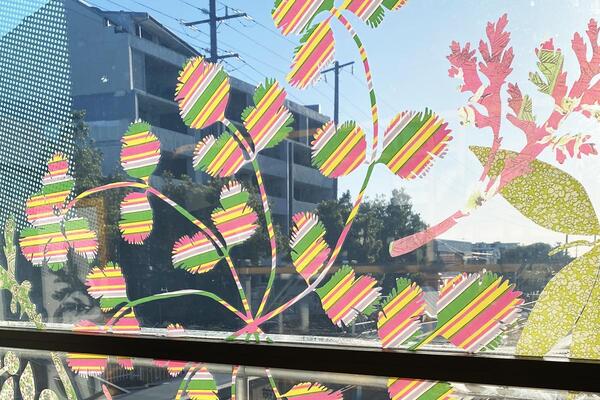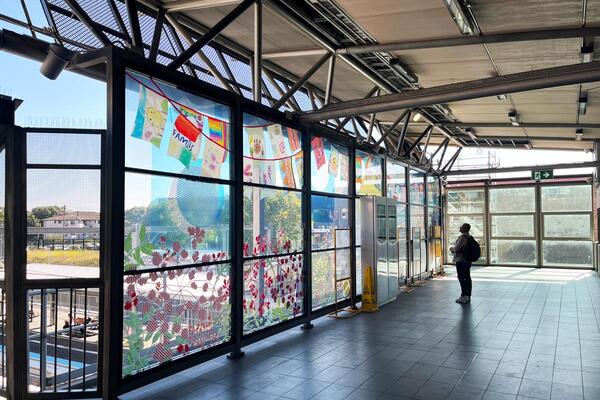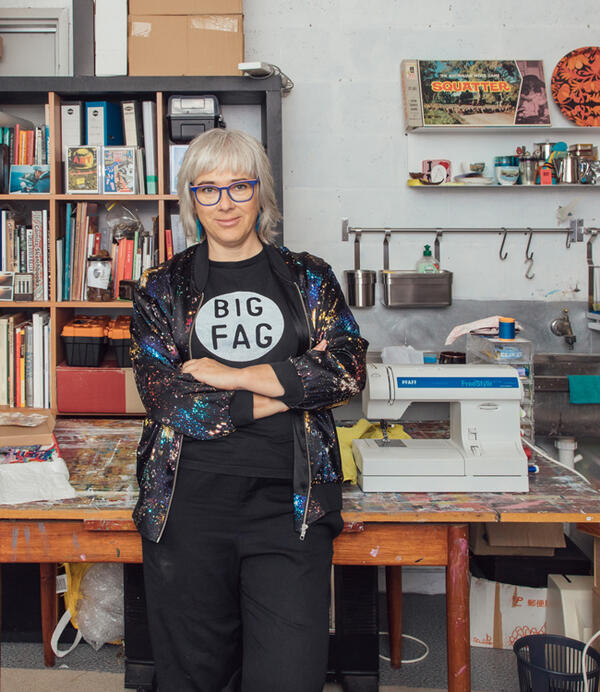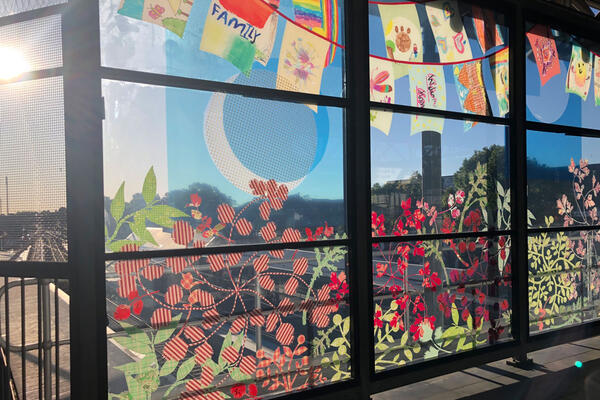
Welcome Home to Beamish Street
A vibrant glass collage welcomes all and celebrates diversity and belonging in Campsie communities.
Image

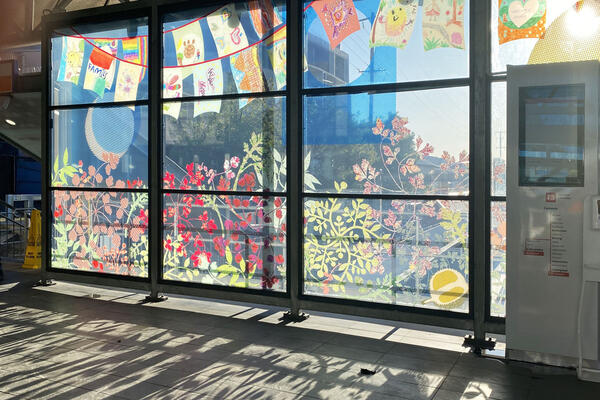
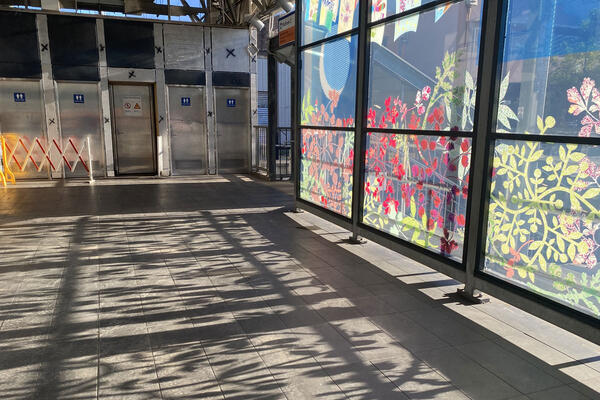
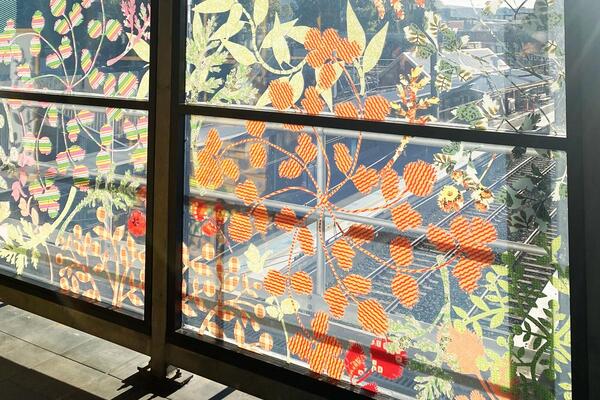
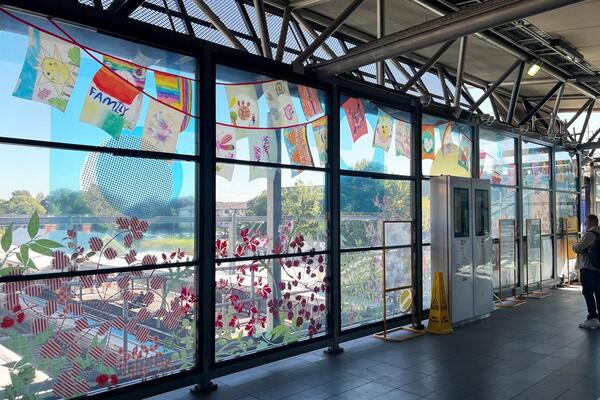
Image controls:
About the artwork
Welcome Home to Beamish Street by Raquel Ormella is located on concourse glass at the entrance to Campsie Station. It forms part of the suite of transparent artworks in station concourse glazing at the 10 Metro Stations from Marrickville to Bankstown.
Ormella’s artwork interlaces stylised depictions food plants – parsley, coriander, common mint, Vietnamese mint, cumquats, and bay leaves – in repeated circular motifs. Plant stencils are filled with vibrant prints. The patterns and designs draw from a variety of cultures and time periods, including Indonesian, Indian, Japanese, and vintage Australian fabrics.
The colours and patterns recall the displays of brightly colour fruit, cakes, and packaged goods available in the Beamish Street shops.
A string of flag bunting spans the glass panels. These flag designs were workshopped with children in the area, exploring the theme of home. Ormella was inspired by a photo of ex-servicemen returning from WWI greeted by banners and bunting. It is also reminiscent of bunting made of the flags of many nations that adorn multicultural food festivals and markets today.
Artist Statement
"One of the key design elements is a flag bunting that is across the whole of the panels. This element is drawn from a photograph of the returning soldiers from World War I. The design been altered and is reminiscent of bunting of multicultural food festivals that uses the flags of many nations.
Rather than designing flags that are representative of national identity children were invited to design a flag that represents their concept of ‘home’ or arriving home to Campsie and Beamish Street. These designs were then incorporated into the bunting in the design.
I was keen to provide opportunities for children of the Campsie community to see their voices reflected in public infrastructure.
The flag is a key motive in my oeuvre and this design will continue to resonate with the changing identity of Campsie, changing attitudes to flags and continue to connect public audiences.
This work includes cues to the area’s European history, yet focuses on its contemporary realities celebrating Campsie’s diverse communities and First Nations peoples.
One of my inspirations is the poetry of Eileen Chong. Chong is a Chinese Singaporean Australian poet who often writes about food, pleasure, and relationships. I really enjoy her poem Eating Durian that describes the excitement and anticipation of eating this fruit. In Singapore on the Mass Rapid Transit system you see symbols like the “no smoking” signs that has the outline of a Durian in place of the cigarette.
I wanted to include a Durian in my design as a nod to Eileen’s work and the South East Asian joy for durian, while knowing its smell is disturbing for those who are not “fans”. The single cut durian sits in the centre of the design surrounded by the motifs of spinning coriander, parsley, mint, Vietnamese mint, cumquats and bay leaves."
Artist Biography
Raquel Ormella is most renowned for her work that provides poignant statements on human relationships to the environment, socio-political systems, class, and community dynamics. She has a diverse material practice that includes video, installation, textiles and creating zines. She is a high-profile artist whose 25-year practice is consistently written on and curated into exhibitions.
Ormella’s work has been featured in Biennale’s and major exhibitions across the world including Biennale of Sydney, Asian Art Biennial, California-Pacific Triennial, Aichi Triennale Japan, and Istanbul Biennale amongst others.
Her work was included in the landmark exhibition Australian Woman Artists 1901 to Now, as part of the National Gallery of Australia’s Know My Name program.
Ormella is a Senior Lecturer at the School of Art & Design, Australian National University, Canberra. She is represented by Milani Gallery, Brisbane.

